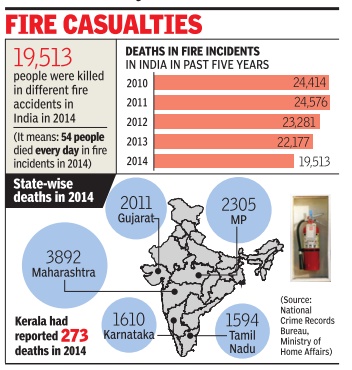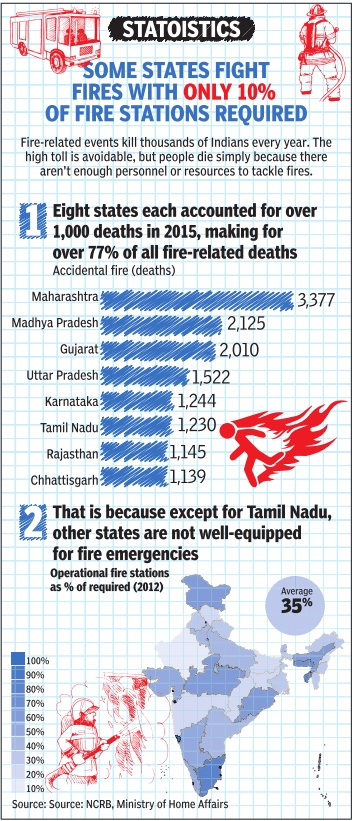Fire accidents (accidental fires): India
This is a collection of articles archived for the excellence of their content. |
Contents |
The extent of the problem in…
1995-2016

See graphic:
Fire accidents, a timeline, 1995-2016
…April
2018
Jayashree Nandi, Nasa images show an India dotted with fires, April 30, 2018: The Times of India

From: Jayashree Nandi, Nasa images show an India dotted with fires, April 30, 2018: The Times of India
Nasa images from the past ten days show large parts of India are dotted with fires stretching across Uttar Pradesh, Madhya Pradesh, Maharashtra, Chhattisgarh and even some southern states. In a sweltering summer, these fires are augmenting the heat and causing pollution via release of black carbon, a component of soot with high global warming effect.
Some of these dots may be forest fires but Hiren Jethva, research scientist at Nasa Goddard Space Flight Center, says fires in central India may be mostly crop fires as forest fires are usually uncontrolled and, therefore, produce more smoke and haze.
Agricultural scientists are linking the massive rise in crop fires in recent years to the dependence of farmers on combine harvesters, which leave a short stubble behind. The practice of stubble burning is not limited to the northern states of Haryana and Punjab.
While burning of paddy stubble has been a common practice among farmers because it is unsuitable as fodder, increasing incidence of wheat stubble burning is a relatively new trend. States with crop fires seen in the Nasa maps have a dominant ricewheat cropping system. There are two choices of harvesting for farmers — manual or combine. But with acute shortage of labour, combines are turning out to be the quickest and cheapest mode of harvesting and preparing soil for paddy.
“I suspect that the use of combines is increasing across the country. I found that the single most important determinant of burning crop residue is the use of combines,” says Ridhima Gupta, an Indian School of Business researcher, who studied the economics of farm fires in Punjab. During her research, she found that using manual labour is twice as expensive as a harvester, and that crop stubble burning accounts for nearly 14% of the country’s black carbon emissions.
The highest number of fires is being seen in Madhya Pradesh. About 10 farmers have already been detained this year in Sehore for burning wheat stubble that spread fire to nearby farms.
Accidents, year-wise
2010-14

The Times of India, Apr 11 2016
Over 1.13 lakh people killed in fire accidents in 5 yrs, most in Maha Most Incidents In Residential Buildings
The death of over 100 people in Kollam has retrained the focus on firerelated accidents that killed over 1.13 lakh people across the country in five years between 2010 and 2014. Though the number of deaths in such incidents has been decreasing in the past five years, the figure still remains uncomfortably high.
Data released by the National Crime Records Bureau (NCRB) of the home ministry showed that 20,377 fire accidents were reported in the country in 2014, which caused 19,513 deaths and injuries to 1,889 people.
The report showed that the maximum deaths in fire accidents in 2014 were reported from Maharashta (3892) followed by Madhya Pradesh (2305), Gujarat (2011), Karnataka (1610), Tamil Nadu (1594), UP (1164), Chhattisgarh (1089) and Rajasthan (1034). Among Union Territories s), the maximum casual (UTs), the maximum casualties in 2014 were reported from Delhi (170) followed by the Andaman & Nicobar Islands (18), Daman & Diu (16), Chandigarh (14) and Puducherry (12). The cause-wise analysis of fire accidents showed that the maximum (18.3%) incidents were reported in residential buildings.
Other causes included fire in school buildings, mines, trains, private vehicles, government buildings and manufacturing units of combustible materials like crackers and match boxes.No separate data for fire in temples is maintained.
Kerala, incidentally , is among states where more than 50% of fire incidents in 2014 were reported in residential buildings. Other states in this category included Punjab, Jammu & Kashmir, Meghalaya, Mizoram and Arunachal Pradesh.
The number of casualties among women was higher than men in 2014. Out of 19,513 casualties in 2014, 12,446 were that of women. The report for 2015 is under preparation.The NCRB compiles such data after getting inputs from all states and UTs.
2015
See graphic, Fire-related deaths in 2015 and the state of preparedness for fire accidents, state-wise

Short circuit blazes
2006-2015

ii)Fires caused by short circuits, state-wise, 2006-2015
From :Ahmed Ali, January 8, 2018: The Times of India
See graphic:
Short-circuit blazes i) Deaths in cities in 10 years due to fire from short-circuit, 2006-2015
ii)Fires caused by short circuits, state-wise, 2006-2015
The city ranked second in fires caused due to short-circuit, with 418 deaths over 10 years, according to National Crime Records Bureau (NCRB) data. Delhi recorded the most short-circuit-related fatalities (424), while Ahmedabad came third with 260 casualties in 2006-15. Short-circuit is a leading cause of fires. Maharashtra, with 1,406 deaths, came third after Andhra Pradesh and Gujarat in that period.
Fire experts said that there was an urgent need for a thorough electrical audit by acompetent engineer, checking the current capacity, insulation, etc.
“The number of casualties will not dip if superficial measures are taken. Changes have to be made in the law,” said former fire chief P D Kargupikar. He added that there was no proper scientific investigation conducted in the aftermath of a blaze. “Most evidence is destroyed while extinguishing the fire,” he said. “Spraying water further washes away the residue. In such circumstances, how does one prove if a short-circuit sparked the blaze? Samples are sent to the state forensic science lab but no positive results are obtained,” said Kargupikar.
Fire department officials said despite repeated warnings, individuals and establishments do not invest in good quality electrical equipment. “Lack of maintenance of equipment could lead to fire-related accidents. Overload of electricity is another cause. A key reason is littering of ducts and dumping scrap in buildings, which provides easy ignition to fire. Many buildings don’t even have a proper refuge area or an escape route,” said an official.
Kargupikar said many people get rid off earth-leakage circuit-breakers (ELCB) as they may cause tripping too often. An ELCB is a safety device used in electrical installations to prevent electric shocks. It detects the smallest of stray voltages on the metal enclosures of electrical equipment and interrupts the circuit if dangerous voltage is detected. “Electrical wires have to be selected as per load. It is necessary to ensure they are ISI-certified and not sub-standard. Similarly, with a circuit-breaker, cost should not be a factor during installation,” added Kargupikar.
Chief fire officer P S Rahangdale said most fires here were due to electrical reasons. “Poor maintenance of wiring makes it vulnerable. Wiring gets oxidised due to exposure to weather. Most fatalities are due to inhalation of gas or smoke emitted after burning of wires and due to fear,” he said.
See also
Fire accidents (accidental fires): India